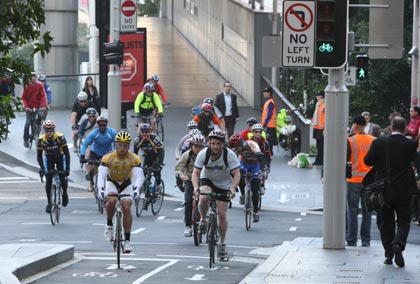Boris Johnson. Mayor and cyclist. Source: Press Association
Bikes are the talk of the town these days, and for good reason. Their renewed surge in popularity has been immense. The number of commuter cyclists in NYC has doubled over the last five years; Italy has recently recorded that bike sales have surpassed car sales for the first time since WWII; and for the first time in decades, a London borough (Hackney) has recorded that more people cycle to work (15%) than drive (12%). But this isn’t all just a fad. To prove my point, I’d like to give you a brief snapshot of some of the amazing things happening across the globe in terms of bicycle infrastructure…
Since you’re reading the Europe section of Trending City, I’d better start with the UK…
King Street, Sydney. Image: Peter Rae
London mayor Boris Johnson last week announced that the city will invest about £1 billion into cycling infrastructure over the next decade (with most being spent in the next few years). Yep, £1 billion! That’s a lot of money. So what’s actually happening? In addition to further investment into the Barclays Bikes Scheme (‘Boris Bikes’), 80,000 new cycle parking spaces are to be added, new cycle routes will be built, public pumps will be installed, junctions will be redesigned and signage improved. And perhaps the most exciting thing in my opinion is investment into new Cycle Superhighways, similar to those in Copenhagen. These will not only give cyclists the opportunity to cover large distances at fast speeds without the hassle of private vehicle congestion, but will also help link up some of London’s more deprived outer boroughs into the inner city cycling network.
The Hangzhou Scheme has taken off in a big way. Source: HZZXC
When I used to think of the United States, I’d think of the most car-dominated, sprawled and un-cycle-friendly streets in the world. But that perception too seems to be changing. New data from the Dept of Transportation has revealed that the number of people riding to work has increased by about 40% over the last decade alongside large investments into cycling infrastructure by both the Federal government and local authorities. Between 2007 and late 2011 over 350 kilometres of bikes lanes were been built in NYC. Although contested (parking, access for the elderly, pedestrian safety, cycle speeds, etc), these lanes mark a massive shift in culture towards a new cycling culture within the city. And it doesn’t look to be slowing; the Citigroup bike share scheme set to open next month will include 600 docking stations across the city.
Although once the “bicycle kingdom”, when most news sources report on mobility in Chinese cities, it’s all about rising congestion due to the growing dominance of the car. But in truth, most Chinese cities still have very high rates of cycling by world standards. And rather than rushing for a petrol-addiction as many western nations did in the 60s, it appears that China could actually, once again, be falling in love with the bike. Not only is it once again fashionable to ride a bike in Chinese cities, but China’s new bike share programs are now the largest in the world. The Hangzhou Program is expected to increase from 2,800 bikes in 2008 to 175,000 by 2020.
And now, let’s take a look at what’s happening in Australia. Following the US model for sprawled cities and car dominance, Australia has had required the help of some bold politicians to get the ball (...or wheel) rolling. Sydney’s Clover Moore has been highly proactive by building a new cycling network, as well as investing heavily into a marketing campaign to get people on two wheels. The process to alter dangerous road networks has seen some great infrastructure planning from both the public and private sectors. Landscape architecture firm Spackman Mossop and Michaels have given us a look at some of their really inspiring recent projects, which you can check out here. While helmet laws are holding back bike sharing systems in many Australian cities, Melbourne and Brisbane have taken the leap to show that the massive growth in bike sharing, is not just a northern hemisphere trend.
This quick glimpse at what’s happening around the world, proves that the latest cycling movement is not all just about hipsters on fixies. Rather, it’s all part of a much more long-term global move to create more sustainable and efficient urban areas. So, with that said, ride on!


